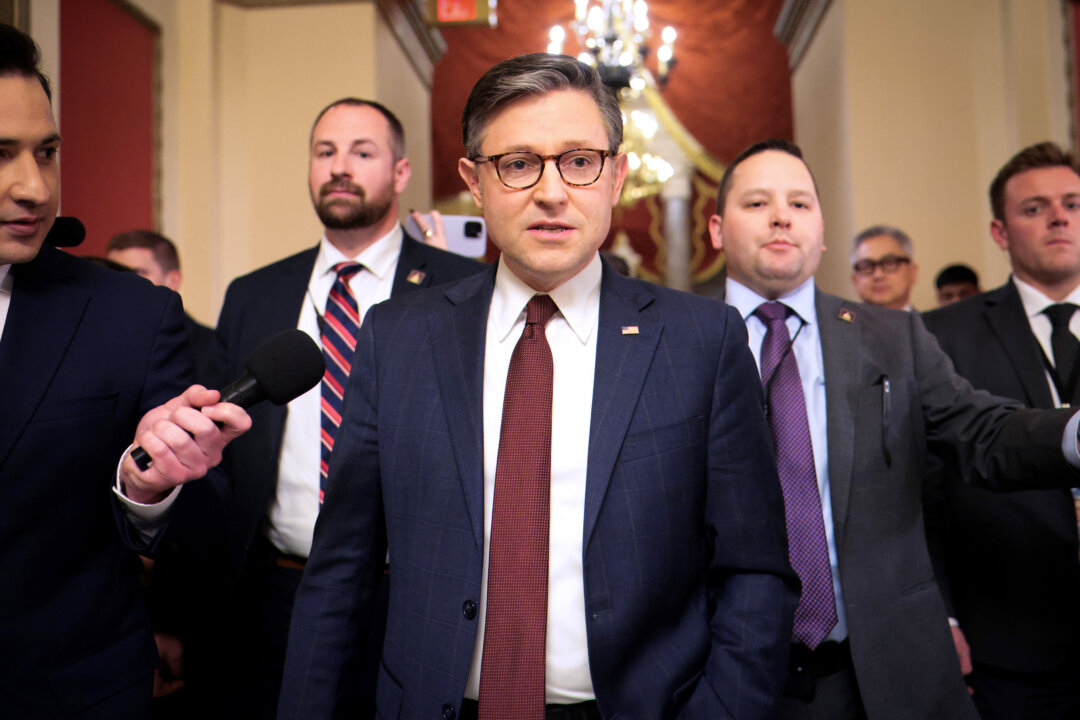It’s the first step in what is expected to be a protracted battle to bring the thin Republican House majority in line with a single package approach.
WASHINGTON—The U.S. House of Representatives on Feb. 25 gave the green light to House Speaker Mike Johnson’s (R-La.) blueprint for a massive budgetary package to carry out President Donald Trump’s agenda.
The House approved the resolution in a 217–215 vote. It authorizes relevant House committees to find at least $1.5 trillion in spending cuts, $4.5 trillion in tax cuts, and a $4 trillion bump to the debt ceiling.
Only a single Republican, Rep. Thomas Massie (R-Ky.), voted against the resolution, while one Democrat, Rep. Raul Grijalva (D-Ariz.), is away for medical reasons.
The vote on the proposal occurred just minutes after leadership announced last-minute that they were pulling it from the floor. Many lawmakers who were leaving the Capitol had to hurriedly return to the chamber.
Republicans gave a round of applause after the final Republican ballot had been cast, reflecting the relief after uncertainty and speculation had surrounded the proposal in the days leading up to the vote. Many went to personally shake Johnson’s hand, marking the political victory he had achieved after weeks of skepticism from both Senate Republicans and political commentators.
The resolution’s passage means that work will now be sent to multiple committees in the House, with assignments to find potential spending cuts and to draft legislative proposals in areas related to border security, defense, energy, and taxes.
The vote’s success represents only the first step in what is expected to be a protracted battle to bring the razor-thin Republican House majority in line with a single package to institute Trump’s agenda. The current composition of the House means that Republicans can spare only a single defection in high-stakes votes.
This factor, more than any other, has informed Johnson and House Republicans’ single package approach, in which all major Republican priorities would be passed in a massive single bill.
Johnson’s victory in advancing the proposal belies the difficulty of his task ahead, however.
In a conference that counts both blue district Republicans and deep-red rural and suburban district Republicans finding agreement on any major controversy—much less a package fated to be full of them—that is far easier said than done.
Republicans Divided on Cuts
Ahead of the initial vote on the blueprint, this problem was manifest as multiple Republicans expressed opposition, for sometimes completely contradictory reasons.
For instance, Reps. Nicole Malliotakis (R-N.Y.), Jeff Van Drew (R-N.J.), and Don Bacon (R-Neb.) made clear that they had concerns about the package because of its potential impact on Medicaid.
Under the terms of the blueprint, the House Energy and Commerce Committee would be expected to find at least $880 billion in spending cuts in programs and agencies under its umbrella, which includes Medicaid.
Meeting that nearly $1 trillion top-line would practically necessitate cuts to the popular health care entitlement program—cuts that could be political suicide for some Republicans in particularly Medicaid-reliant districts.
On the other side of the Republican ideological spectrum, however, Reps. Victoria Spartz (R-Ind.) and Massie also expressed concerns.
Spartz tied hers specifically to a demand for greater investigation and cuts to Medicaid, which Spartz suggested was potentially rife with abuse due to the automatic nature of the program’s funding.
Massie, meanwhile, noted that the budget plan—whose $4.5 in tax cuts far outpaces the $1.5 trillion spending cuts in the current proposal—would have a long-term negative impact on the deficit.
However, all of these defectors, with the exception of Massie, ultimately came around to the proposal—though the ideological divides between them will likely continue as the lower chamber moves onto the long process of drafting a final bill.
Senators Have Doubts
Senate Republicans have been open about their skepticism that Johnson can complete the task.
Last week, the Senate passed the first draft of its two-part budget plan, which would punt on the tax issue, while making immediate changes to border, defense, and energy budget and policy.
Trump has openly endorsed Johnson’s approach over the Senate’s proposal but has also signaled he would accept a two-part package if required.
Senate Majority Leader John Thune (R-S.D.) has said that the Senate’s counter-proposal is solely intended to provide “optionality” to the White House.
Senate Budget Committee Chairman Lindsey Graham (R-S.C.), a principal actor in the Senate’s two-track approach, has openly indicated that he believes Johnson will be unable to pass a single package through the lower chamber.
After four years in the minority, Republicans now have a narrow 53-seat majority in the upper chamber.
Nevertheless, both Thune and Graham have indicated that a single massive package would be their preference if Johnson can pull it off.
Whether Congress ultimately takes up the House or the Senate approach will depend primarily on the outcome of the next several weeks of backroom haggling and negotiations within the House Republican conference.
Johnson told The Epoch Times ahead of the vote series on Tuesday that he didn’t see the Senate proposal as a “Plan B.”
“There is no Plan B,” Johnson said. “This is the only plan we’re running with.”
Johnson has said that he hopes to complete work on the package by April, with final passage by May.

